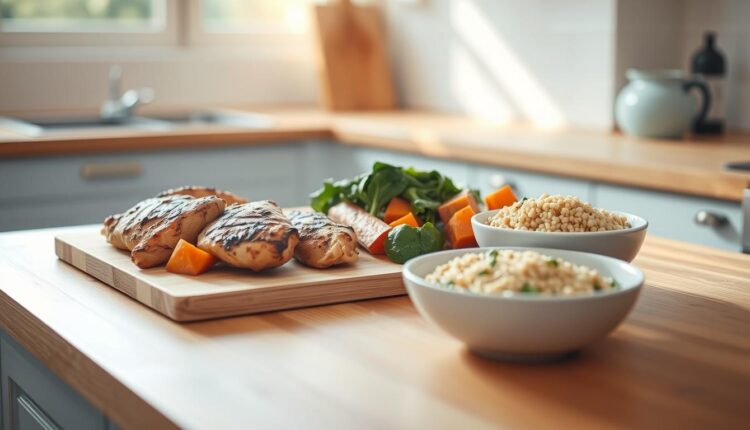High Protein Lunch Prep Recovery Meals After Workouts
Recharge with high protein lunch prep recovery meals. Learn simple meal prep techniques for busy professionals and fitness enthusiasts.
47% of Americans skip proper refueling after exercise, according to recent nutrition surveys. That’s like changing your car’s oil but forgetting to fill the gas tank. Your body deserves better than rushed snacks or drive-thru fixes between workouts and work meetings.
I’ve spent years helping clients create prep-ahead solutions that actually fit real life. Every recipe here delivers at least 15 grams of muscle-supporting fuel per serving – without complicated techniques or Instagram-perfect containers. We’re focusing on dishes that balance two priorities: helping your body rebuild stronger and keeping your energy steady through busy days.
Why This Works
- Smart prep turns kitchen time into freedom later
- Flavor-packed combinations prevent lunch boredom
- Nutrient balance supports both strength goals and overall wellness
Introduction to High Protein Recovery Meals
Picture this: It’s Wednesday afternoon. Your energy crashes after back-to-back meetings, and the drive-thru whispers your name. This is where intentional kitchen planning becomes your secret weapon. Thoughtfully prepared dishes transform chaotic days into nourishing routines – no chef skills required.
Batch cooking lets you make one smart decision that pays off all week. Take Tuna Salad Lettuce Wraps – ready in 15 minutes, packed with 18g of muscle-supporting fuel. Or Caprese Pasta Salad, where fresh mozzarella meets whole-grain noodles for lasting energy. These flavor-forward combos prove practical eating doesn’t mean boring.
“Sunday’s one hour of chopping and roasting saves me 7+ hours weekly,” shares a client juggling parenting and marathon training.
| Meal Type | Avg Protein | Cost Per Serving | Active Prep Time |
|---|---|---|---|
| Homemade | 22g | $3.50 | 12 min |
| Takeout | 14g | $11.75 | 25 min |
Our community-focused approach means every recipe works for real kitchens. Whether you’re feeding picky teens or powering through conference calls, strategic meal prep turns nutritional goals into grab-and-go reality. Let’s ditch the guilt trips and embrace delicious solutions that fit actual lives.
Benefits of Protein for Post-Workout Recovery
The real magic of fitness happens after you leave the weight room. Those first 60 minutes post-sweat session are when your body shifts into repair mode. I learned this the hard way during my first year of culinary school—skipping proper refueling left me dragging through afternoon knife skills classes.
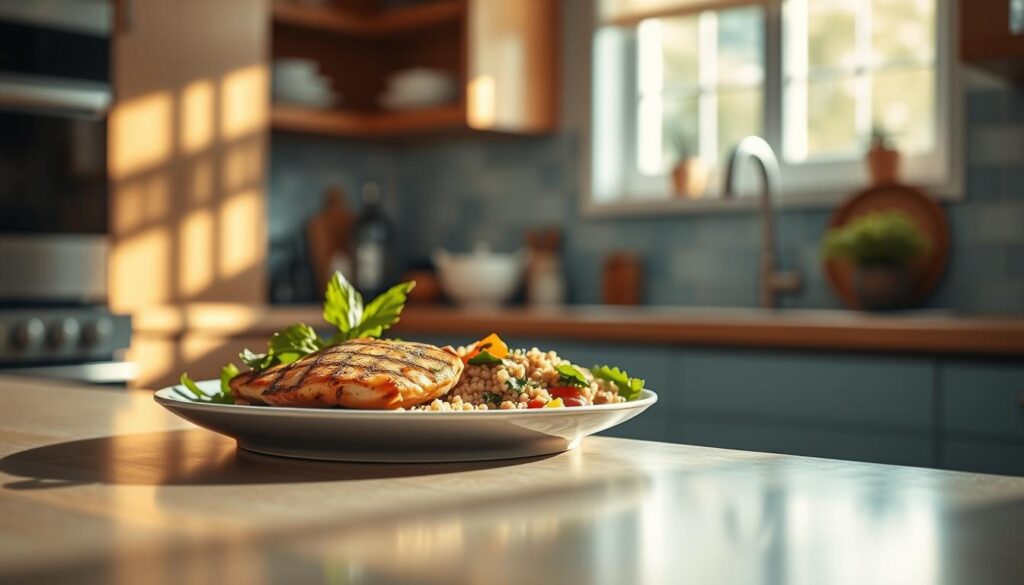
How Quality Fuel Supports Muscle Repair
Every resistance session creates micro-tears in muscle fibers. Amino acids act like microscopic repair crews. Studies show consuming 20-30 grams within two hours post-exercise reduces muscle breakdown by up to 50%.
“I added hard-boiled eggs to my post-yoga routine,” I recall. “The difference in next-day mobility shocked me—no more hobbling to the farmer’s market!”
Sustained Energy and Fewer Cravings
Balanced intake stabilizes blood sugar better than carb-heavy snacks. This prevents the 3 PM energy crash that triggers vending machine raids. For steady vitality:
- Combine lean sources with whole grains
- Add avocado or nuts for staying power
- Distribute intake across meals
Pro tip: Divide your weight (lbs) by 2.2 for daily minimum grams. A 150-lb person needs ~68g—about what’s in 3 chicken thighs and a Greek yogurt.
Time-Saving Meal Prep Techniques
Your kitchen timer isn’t the only thing that benefits from smart shortcuts. Strategic cooking methods turn chaotic evenings into streamlined success. Let’s explore how to maximize flavor while minimizing effort.
Effortless Assembly Strategies
I discovered the power of modular components during my busiest catering season. Roast two sheet pans of veggies while cooking grains. Store them separately, then mix-and-match all week. Try these no-fuss ideas:
| Method | Time Saved | Meals Produced | Key Tools |
|---|---|---|---|
| Sheet Pan Roasting | 35 min | 4 | Parchment paper |
| Instant Pot Basics | 18 min | 6 | Multi-cooker |
| Freezer Packs | 0 min* | 8 | Reusable bags |
*Pre-prepared ingredients ready for quick reheating
Batch cooking transformed my Sunday routine. I now cook triple portions of versatile bases like quinoa or shredded chicken. These become tacos, stir-fries, or salad toppers in minutes. “Components beat complete meals for flexibility,” I tell clients managing unpredictable schedules.
“Pre-chopped veggies and cooked grains let me assemble lunches faster than ordering delivery,” shares a nurse working 12-hour shifts.
Keep dressings and sauces in squeeze bottles for drizzle-ready flavor. Store crunchy toppings separately to maintain texture. With these tweaks, even last-minute meals feel intentional rather than rushed.
Understanding Your Protein Needs
Ever wonder why some days you feel unstoppable and others you’re dragging? Your plate might hold the answer. Tailoring your protein intake to your body and routine turns guesswork into strategy. I learned this when a client doubled her strength gains simply by adjusting her portions to match her cycling regimen.
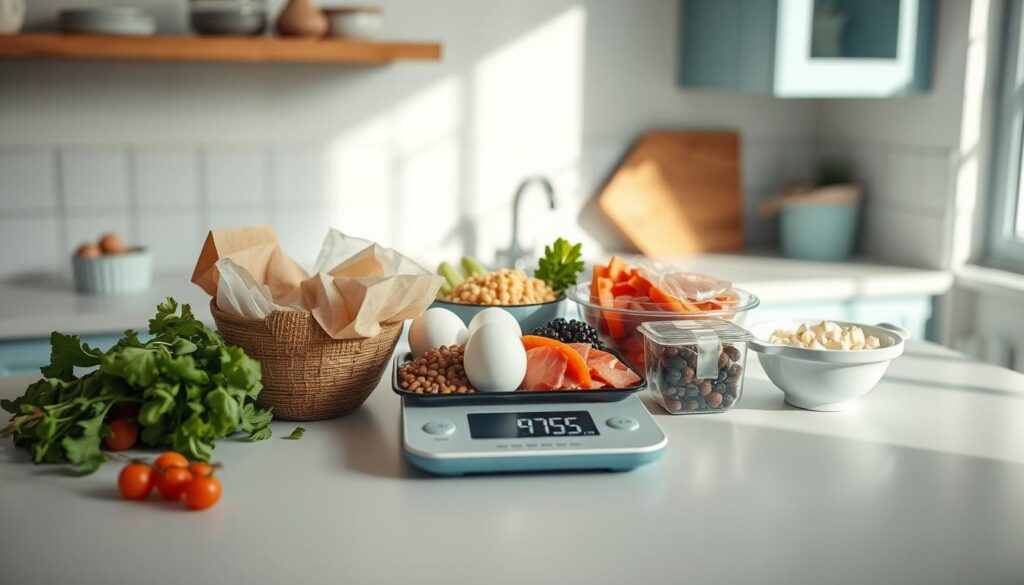
Calculating Your Daily Intake
Start with your weight and activity level. For most active adults:
- Divide your weight (lbs) by 2.2 to get kilograms
- Multiply by 1.2-2.0 based on workout intensity
| Activity Level | Multiplier | Example (150-lb person) |
|---|---|---|
| Light Exercise | 1.2 | 82g |
| Strength Training | 1.6 | 109g |
| Endurance Athlete | 2.0 | 136g |
Spread your protein per meal across 3-4 servings. A teacher client of mine aims for 30g at breakfast: “Scrambled eggs with cottage cheese keep me focused through parent conferences.”
Tracking doesn’t require spreadsheets. Try these simple methods:
- Use portion-control containers during prep
- Snap meal photos for later review
- Try free apps that scan nutrition labels
Your needs will shift with seasons and goals. A marathon trainee might need more grams per day during peak weeks, while someone recovering from injury adjusts downward. Listen to your energy levels—they’re better feedback than any calculator.
Key Ingredients for Nutrient-Dense Meals
Building meals that fuel recovery starts with smart ingredient choices. Think of your grocery cart as a toolbox – each item should serve a purpose. Fresh, minimally processed components deliver maximum nutritional impact without complicated prep work.
Lean Meats, Poultry, and Fish
Animal-based options pack concentrated nutrition. Skinless chicken thighs offer more flavor than breasts while keeping fat reasonable. Wild-caught salmon brings omega-3s to the table – try baking a large fillet to flake over salads.
| Protein Source | Grams per 3oz | Prep Tip |
|---|---|---|
| Chicken Breast | 26g | Shred for tacos |
| Canned Tuna | 20g | Mix with Greek yogurt |
| Salmon | 22g | Roast with citrus |
Plant-Based Powerhouses
Lentils and chickpeas shine in meatless meals. I blend cooked lentils into tomato sauce for hidden richness. “Crumbled tempeh makes killer taco filling,” shares a vegan client who trains for triathlons.
Combine these ingredients for balanced plates:
- Roasted veggies add fiber and crunch
- Quinoa or farro boosts whole grains
- Avocado slices provide healthy fats
Store proteins in portioned containers for grab-and-go assembly. Keep fresh herbs in water-filled jars to maintain vibrancy. With thoughtful selection, every bite becomes an investment in your energy reserves.
high protein lunch prep recovery meals
Your muscles aren’t the only thing craving attention after a tough workout. Strategic use of dairy transforms ordinary dishes into recovery powerhouses. Greek yogurt became my kitchen MVP during culinary school finals – its creamy texture and 20g per cup made rushed meals feel intentional.
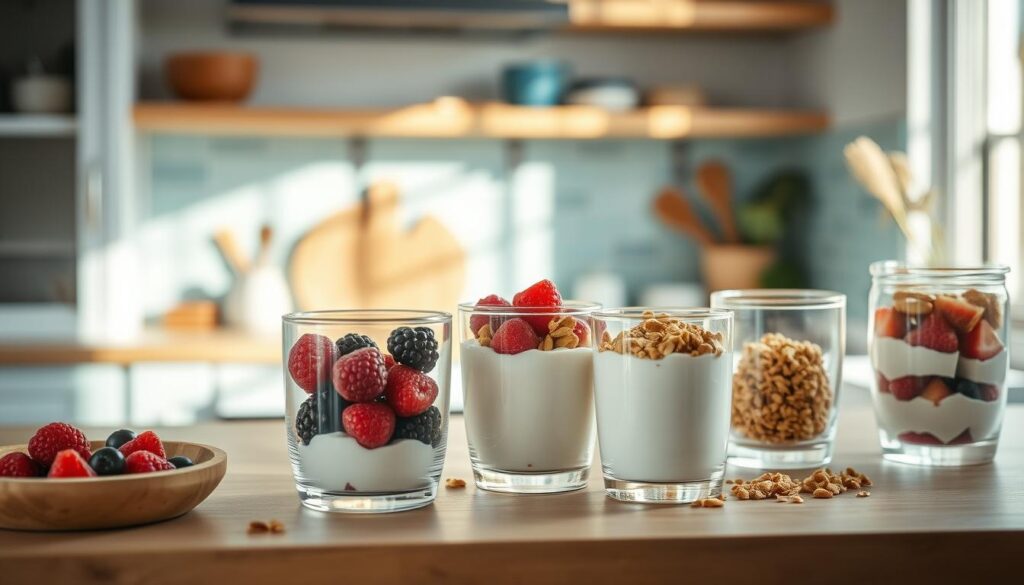
Swap mayo with plain Greek yogurt in chicken salad or dips. It adds tangy richness while cutting 75% of the calories. “I mix it with lemon zest and dill for fish tacos,” shares a client training for her first triathlon. “Tastes indulgent but keeps me light on my feet.”
Cheese plays double duty in smart meal prep. Crumbled feta elevates grain bowls, while cottage cheese blends seamlessly into smoothies. A sprinkle of sharp cheddar melts into egg muffins, delivering 7g per serving without heavy sauces.
“My kids think they’re eating ‘fancy mac and cheese’ – really it’s Greek yogurt sauce with whole-grain pasta,” laughs a mother of three.
These ingredients shine in both classic and creative formats:
- Yogurt-based dressings revive leftover greens
- Ricotta-stuffed chicken stays juicy for days
- Cottage cheese pancakes freeze beautifully
For those managing inflammation, dairy-packed meals offer built-in benefits. The calcium supports muscle function, while probiotics aid digestion. Just remember – full-fat versions keep you fuller longer than their low-fat counterparts.
Delicious Chicken-Based Meal Prep Recipes
Your taste buds and gym gains don’t have to play tug-of-war. Chicken’s blank-canvas quality makes it the ultimate foundation for creative, satisfying dishes. I discovered this during my first food truck gig – we sold out of citrus-herb shredded chicken bowls three days straight.
Salad Transformations
Rotisserie chicken becomes your weekday hero. Try these combos:
- Curry chicken salad with grapes and almonds
- Buffalo-style wraps with celery slaw
- Mediterranean pita pockets with tzatziki
A client who works construction shares: “I layer mason jar salads – dressing at the bottom, then grains, then chicken. Stays crisp till lunch.”
Heat-and-Eat Bowls
Batch-cook seasoned thighs while roasting veggies. Portion into containers with:
| Base | Mix-Ins | Sauce | Prep Time |
|---|---|---|---|
| Brown rice | Roasted broccoli | Peanut drizzle | 12 min |
| Quinoa | Sautéed peppers | Chimichurri | 15 min |
“Crustless quiche with leftover chicken and spinach became my office breakfast savior,” says a teacher prepping for standardized testing week.
Marinate breasts in freezer bags with olive oil and spices – thaw overnight for quick grilling. Store shredded meat in ½ cup portions for instant tacos or stir-fries. Chicken’s versatility means you’ll never face “meal prep burnout.”
Flavorful Seafood Options for Recovery
Ocean treasures offer more than beachside views—they’re kitchen MVAs for post-workout nourishment. Salmon and tuna bring coastal vibes to your meal containers while delivering essential nutrients. These swimmers pack omega-3 fatty acids that reduce exercise-induced inflammation, according to recent studies.

Salmon and Tuna Meal Preps
Wild-caught salmon shines in quick sheet pan dinners. Try this weeknight hero: maple-glazed fillets with roasted tomatoes and asparagus. The natural oils keep fish moist during reheating—no dry, flaky disappointments here.
| Seafood | Protein per 4oz | Omega-3s (mg) | Prep Idea |
|---|---|---|---|
| Salmon | 23g | 2,000 | Pesto-crusted bake |
| Tuna | 28g | 300 | Sesame-seared steak |
A client training for her first marathon swears by tuna poke bowls: “I prep marinated cubes Sunday night—just add avocado and rice cakes before work.” For time-crunched days, canned versions work beautifully in salads or wraps.
Simple sauces transform basic dishes. Whisk together:
- Greek yogurt + lemon zest (for salmon)
- Soy sauce + ginger (for tuna)
- Tomato salsa + lime juice (universal)
“Seared tuna with sweet potato wedges became my post-swim ritual—ready faster than takeout,” shares a triathlete balancing parenting and training.
Discover more kitchen-tested ideas in our collection of seafood recipes. These dishes prove that fuel-focused eating can taste like coastal vacation vibes—no passport required.
Creative Vegetarian and Vegan Protein Ideas
Plant-powered plates prove you don’t need meat to refuel effectively. Legumes and soy-based ingredients offer versatile foundations for meals that satisfy both taste buds and fitness goals. Let’s explore how to turn humble pantry staples into crave-worthy dishes.
Lentil, Chickpea, and Tofu Recipes
Beans and lentils pack double benefits – they’re rich in fiber and plant-based fuel. Try these kitchen-tested ideas:
- Smoky lentil tacos with avocado crema
- Chickpea “tuna” salad with celery and capers
- Marinated tofu bowls over turmeric rice
“Meal-prepped curried lentils got me through marathon training,” shares a client who transitioned to plant-based eating. “I freeze portions with spinach for instant post-run meals.”
| Legume | Protein per Cup | Fiber | Prep Hack |
|---|---|---|---|
| Black Beans | 15g | 15g | Mash for burger patties |
| Chickpeas | 14g | 12g | Roast with paprika |
| Lentils | 18g | 16g | Use in veggie loaf |
Boost texture and nutrition with fresh veggies. Shredded carrots add crunch to wraps, while roasted zucchini keeps grain bowls interesting. For creamy richness without dairy, blend avocado into dressings or layer slices into sandwiches.
Batch-cook components like spiced lentils or baked tofu on Sundays. Store them with pre-chopped vegetables for quick assembly. These strategies make plant-focused eating practical for even the busiest schedules.
Smart Batch Cooking for Busy Professionals
Thursday at 7 PM used to be my kitchen nightmare—until I discovered batch cooking’s magic. Strategic planning turns chaotic evenings into seamless meals. Let’s transform your weekly routine with systems that work smarter, not harder.
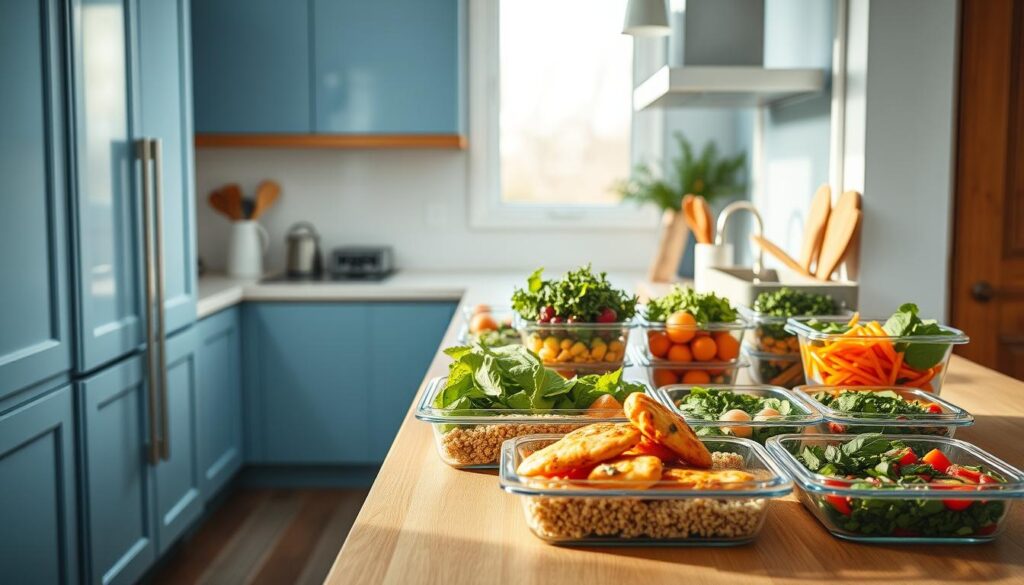
Planning a Week’s Worth of Meals
Start with a 30-minute “menu mapping” session. Jot down three core dishes that share ingredients. My go-to trio: roasted lemon chicken, quinoa pilaf, and chili-lime black beans. These become tacos, grain bowls, or stir-fries throughout the week.
Key strategies for success:
- Cook proteins in bulk (2-3 varieties)
- Prep versatile bases like grains and roasted veggies
- Store components separately for mix-and-match freedom
“I spend 90 minutes on Sundays prepping building blocks—now dinner takes 7 minutes max,” shares a software developer managing twin toddlers.
| Storage Method | Freshness Window | Reheating Tip |
|---|---|---|
| Glass Containers | 4 days | Add splash of broth when microwaving |
| Freezer Bags | 3 months | Thaw overnight in fridge |
Label everything with dates using painter’s tape. Keep dressings and sauces in small jars to prevent sogginess. With this rhythm, you’ll spend less time deciding what to eat and more time enjoying it.
Meal Prep Containers and Storage Solutions
I once lost a week’s worth of lunches to a leaky container disaster – turmeric-stained bags and soggy quinoa everywhere. That messy lesson taught me more about food storage than any cookbook ever could. The right containers aren’t just boxes; they’re your frontline defense against wasted effort and soggy meals.
Seal in Freshness, Lock Out Chaos
Quality matters more than aesthetics. Glass containers with silicone lids keep salads crisp for days, while slim plastic ones stack neatly in lunch bags. Look for these features:
| Type | Best For | Price Range |
|---|---|---|
| BPA-free plastic | Portion control | $2-$5 |
| Glass with dividers | Multi-component meals | $8-$12 |
“I use small ramekins inside larger containers for dressings,” shares a nurse who meal preps during night shifts. “No more wilted greens by Thursday.”
Proper storage preserves texture and nutrients. Airtight seals prevent freezer burn on batch-cooked soups, while separate compartments keep crunchy toppings from turning limp. This attention to detail helps manage portions without calorie counting guesswork.
For budget-friendly solutions:
- Repurpose deli containers (sterilize first)
- Use mason jars for layered salads
- Label everything with washable tape
Discover more batch cooking essentials that pair perfectly with your container system. When your storage game matches your cooking effort, every serving stays as vibrant as day one.
Prepping Breakfast Burritos and Overnight Oats
We’ve all faced that 6 AM dilemma: snooze button vs. proper fuel. Here’s the truth – mornings don’t have to mean rushed coffee runs or skipping nutrients. With smart prep, you can conquer dawn’s chaos while nourishing your body.
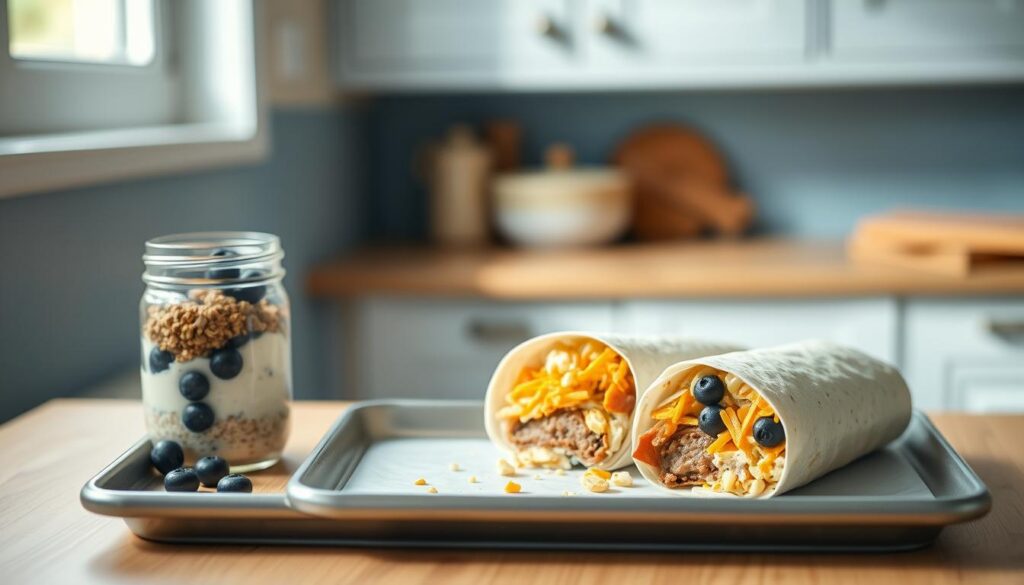
Quick Ideas for a Protein-Packed Morning
Start with eggs – nature’s multitasker. Scramble a dozen with spinach and divide into whole-grain tortillas. Add black beans or shredded chicken for staying power. Wrap in foil, freeze, then microwave straight from the freezer. “My kids grab these before school,” shares a client. “They think it’s fast food – I know it’s 18g of fuel.”
Overnight oats become creamy marvels with Greek yogurt. Mix rolled oats with almond milk, chia seeds, and a scoop of vanilla yogurt. Top with peanut butter or berries come morning. The beauty? Endless variations:
| Base Flavor | Mix-Ins | Protein Boost |
|---|---|---|
| Cocoa | Banana slices | Almond butter |
| Pumpkin Spice | Pecans | Collagen peptides |
“I prep five jars every Sunday – breakfast is done before my brain fully wakes up,” laughs a teacher juggling grad school.
Store burritos in parchment-lined bags to prevent freezer burn. Layer oat ingredients in mason jars – liquid first, toppings last. Glass containers keep everything fresh without plastic taste interference. These strategies transformed my own routine after a disastrous week of soggy wraps and exploded yogurt cups.
Satisfying Salads and Sandwiches for Lunch
Your desk isn’t the place for sad desk lettuce—or soggy bread disasters. Transforming these lunch staples starts with layering textures and flavors that hold up for hours. I learned this during my café days, watching customers’ faces light up over crunchy veggie-packed wraps and vibrant grain bowls.
Fresh Greens and Protein-Rich Fixings
Build salads that stay crisp by keeping wet ingredients separate. Try shredded chicken with massaged kale—the sturdy leaves won’t wilt like delicate greens. For sandwiches, spread hummus on whole-grain bread before adding turkey slices. This creates a moisture barrier to prevent sogginess.
- Grilled zucchini + chickpeas + feta (18g per serving)
- Apple slices + cheddar + roasted chicken (22g)
- Avocado smash + hard-boiled eggs + sunflower seeds
Flavor Boosters and Dressings
Elevate basic dishes with smart condiments. A client shared her trick: “I keep lemon-tahini dressing in small jars—one batch flavors four salads.” Try these pairings:
| Base | Mix-In | Dressing |
|---|---|---|
| Spinach | Steak strips | Balsamic + Dijon |
| Quinoa | Black beans | Lime + cilantro |
“Pre-chopped veggies in mason jars let me assemble gourmet-style sandwiches during Zoom calls,” says a remote worker balancing childcare.
For dietary swaps, use collard wraps instead of bread or dairy-free spreads. The key? Treat each component like building blocks—mix, match, and conquer lunchtime monotony.
Nutrient Timing for Optimal Recovery
Your post-workout meal isn’t just about what’s on the plate—it’s about when you lift your fork. Studies reveal that proper nutrient timing can enhance muscle repair by up to 30%, turning your kitchen rhythm into a strategic recovery tool. Let’s crack the code on syncing meals with your body’s repair cycles.
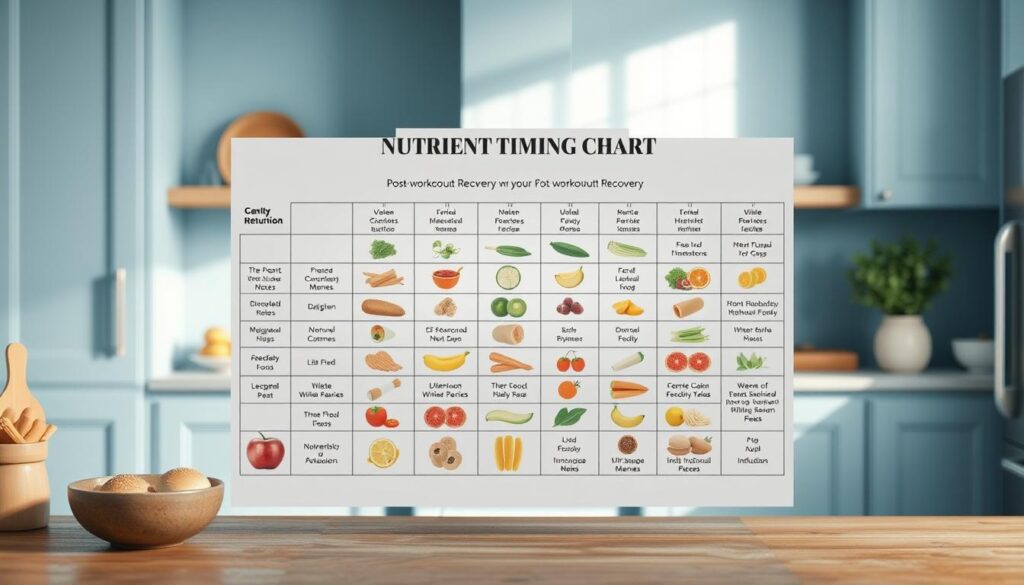
When to Eat for Maximum Benefits
The first hour after exercise acts like a biological green light. During this window, your muscles eagerly absorb amino acids to rebuild stronger fibers. A client who shifted her snack time from 3 PM to immediately post-yoga shared: “My DOMS vanished—I could finally keep up with my toddler.”
Practical schedules for busy lives:
| Activity | Ideal Time Frame | Example Meal |
|---|---|---|
| Morning Workouts | Within 45 min | Greek yogurt + berries |
| Evening Sessions | Pre-bed snack | Cottage cheese + almonds |
“I prep hard-boiled eggs and roasted chickpeas for my construction shifts,” says a father of twins. “Eating every 3-4 hours keeps my energy steadier than coffee ever did.”
Three actionable tips:
- Pair fast-acting carbs with lean protein post-sweat
- Hydrate consistently throughout the day
- Prep grab-and-go snacks for unpredictable days
Remember—consistency beats perfection. Even aligning two meals with your workout rhythm can yield noticeable results. Your body thrives on patterns, not Pinterest-worthy precision.
Balancing Macronutrients for Overall Health
Think of your plate as a symphony—each nutrient plays a crucial note. Getting the harmony right transforms ordinary meals into recovery powerhouses. A client once told me, “When I started pairing grilled chicken with farro instead of white rice, my afternoon energy crashes vanished.”
Combining Proteins, Carbs, and Fats
Quality carbs like quinoa or whole-grain pasta provide lasting fuel. Pair them with lean proteins for muscle support. Dietitian-approved combos:
- Salmon + roasted sweet potatoes + avocado
- Turkey meatballs over zucchini noodles + pesto
- Lentil soup with whole-grain bread
Aim for this ratio at dinner: palm-sized protein, fist-sized carbs, thumb-sized fats. “Clients who follow this visual guide consume 18% more nutrients,” notes sports dietitian Dr. Elena Marks.
Adjusting Portions to Your Goals
Active lifestyles need more carbs for energy. Recovery phases benefit from extra protein. Use these tweaks:
| Goal | Protein | Carbs | Fats |
|---|---|---|---|
| Muscle Gain | 30% | 40% | 30% |
| Endurance | 25% | 50% | 25% |
“Measure portions for two weeks—it trains your eye better than any app,” advises Chef Callie. “Now I eyeball quinoa amounts perfectly for my cycling group’s meals.”
For calorie control, fill half your plate with veggies first. Add proteins and complex carbs to the remaining space. This simple method helps manage intake without obsessive counting.
Conclusion
Your journey to better recovery starts in the kitchen, not the gym. Every chopped veggie and pre-portioned serving becomes a building block for stronger days ahead. What we’ve shared isn’t about perfection—it’s about progress that fits real lives.
Remember these essentials: timing matters most after workouts, ingredient quality beats complexity, and planning trumps willpower. A client once told me, “When I stopped chasing ‘perfect’ meals and focused on consistent flavorful fuel, my energy transformed.”
Start small. Batch-roast one tray of veggies this Sunday. Try freezing individual portions of kitchen-tested meal prep strategies. Notice how intentional choices create ripple effects—better sleep, steadier focus, workouts that feel empowering rather than exhausting.
Your turn. Grab that trusty knife and containers waiting in the cabinet. What delicious experiment will you try first? The path to nourished living isn’t paved with rigid rules, but with smart systems that honor both your goals and your schedule. Let’s make every bite count—without making it complicated.

